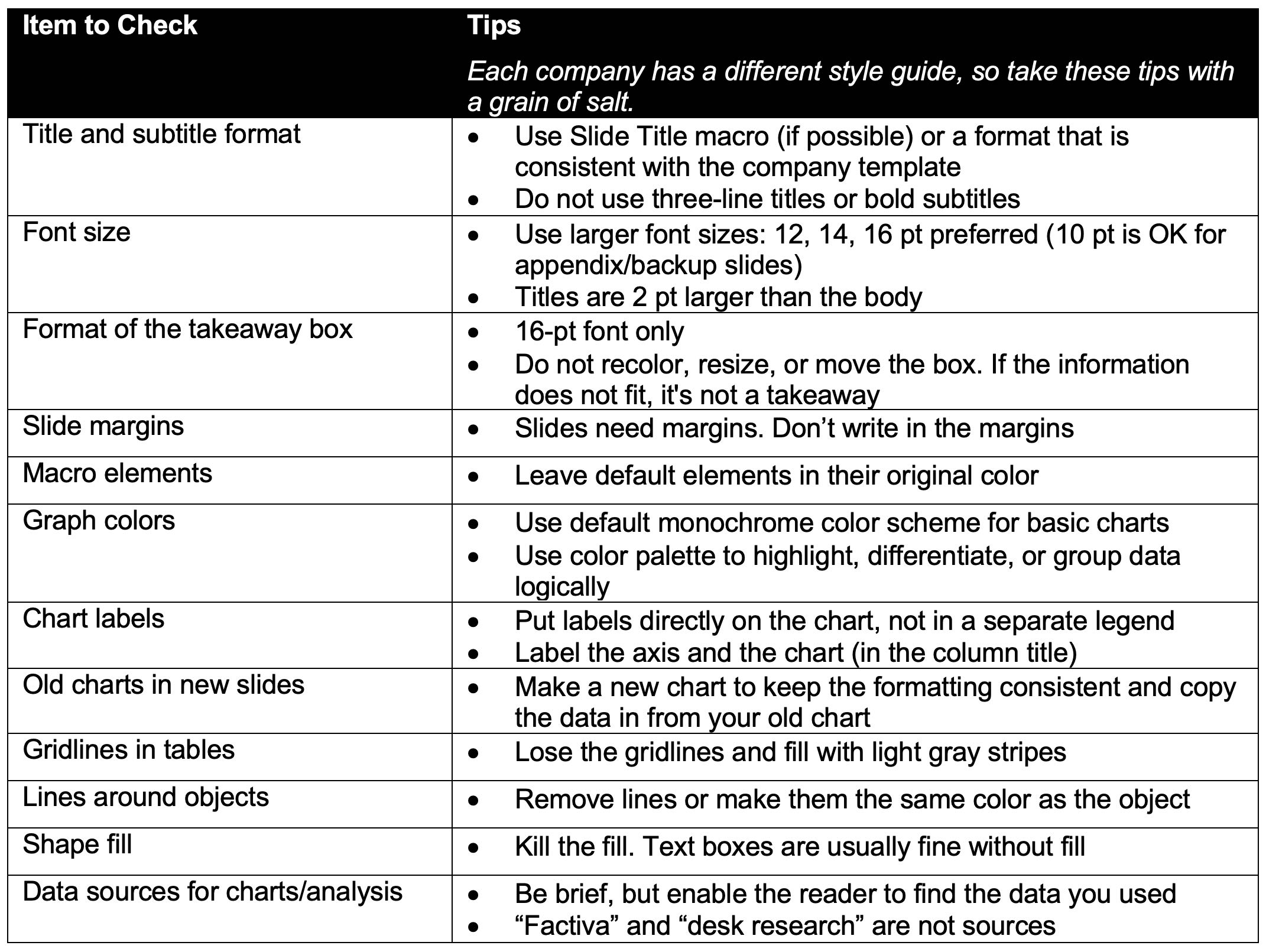In management consulting and many other sectors, people spend a lot of time creating PowerPoint slides as it has become the basis for communicating, both internally and externally. However, slide writing is often very challenging. It forces you to structure your thinking and the slide deck needs to include the right content as well as being interesting, simple, focused, logical, and compelling.
This post will provide you with a guide to creating and perfecting typical slides used to present information in a business context, whether you are a student preparing for a case competition, a fresh consultant who just graduated, or a project manager who has to constantly deliver milestones and progress reports to multiple stakeholders.
Ten Commandments of Slide Writing
- Be clear: one key point per slide
- Answer the “so what?”
- Include a title that reflects the logic of the slide
- Communicate the message graphically
- Start the story flow with conclusions
- Organize the story flow through messages
- Customize the story flow based on your audience
- Use slide titles which alone tell the story
- Check, double check, and triple check your slides for quality (there is a checklist at the end of this post)
- Polish the slides until the quality is flawless, good is not good enough
How to Create Typical Slides
In a business context, there are many types of slides that you will come across time and again. Below we explore the basics of how to build eleven typical slides that are used in a business context.
1. Setup Slide
- The agenda or setup slide is typically used to establish the context, align the objectives of the presentation, or share progress to date
- Effective setup slides serve two goals:
- Ensure that your audience understands the context and basic facts that define the case
- Explain what the problem is and why it is being addressed
- Tailor the agenda and flow based on the audience. Always check before the presentation who the audience is and what this group wants to know
- Write clear and concise content with parallel structure
- Use columns and arrows to guide viewer’s eyes to what’s important
2. Executive Summary
- The executive summary should provide a fact-based, persuasive, clear, and logical storyline:
- Integrate disparate analyses to develop recommendations or novel insights
- Structure findings to explicitly highlight key insights, reveal answers, and bring your audience to an “aha moment”
- Read the main points (bold) to see how the story flows
- Eliminate extraneous information even if you’re excited about the findings. Tell the story that addresses your audience’s concern, not yours
- Use concise, effective wording:
- No more than two rows per bullet point
- No ambiguous wording. Take a strong stand on your arguments
- If presenting to board members, provide a low level of detail
- Write using a parallel structure e.g. consistent verb forms
- Use a numbered summary for discrete findings, e.g. consumer research
- Still use business logic to order and group the findings
- Don’t present findings in a random order, and generally not in alphabetical order
- Use brief but clear sentences
- Remove repetitive phrases
- Simplify, clarify, and use active verbs
- Always write one or two simple summary slides for your module / section / work stream even for case team meetings
3. Matrix Framework
- The matrix framework is frequently used in strategy cases to illustrate what needs to be done to turn the company around with key strategic choices
- The matrix framework is most frequently used in consulting firms to identify sweet spots:
- The matrix can be 2×3 or 3×3, but should not be overly complicated
- Organize both axes from low to high with clear annotation
- Create a simple, illuminating framework to:
- Frame issues
- Crystallize implications
- Guide the audience or create a logical transition between different sets of analysis or between different sections
- Use numbers or colors to distinguish categories
- Consider your chosen axes very carefully
- What’s the logic behind the choice of axes?
- What’s the rationale for the order of the axis scales (from low to high or high to low)?
- Use action-oriented phrases for implications in order to engage the audience and highlight actions
- Use traffic light colors to highlight areas that require distinct strategic action
4. Pyramid Framework
- The pyramid framework is frequently used to show the hierarchical relationship between issues and topics e.g. identifying which steps resulted in the client’s low brand advocacy
- Follow a well-defined framework (e.g. brand pyramid). Don’t re-create a new framework if there is a widely recognized one
- Add a brief explanation next to the framework in case it is new to clients
- Combine a good framework with data to make a powerful claim
- Use colors to carry information, not decorate your slide
5. Pillars Framework
- Pillars help you categorize thoughts and approaches with key building blocks, e.g. org. related topics
- Pay attention to the logic behind the shape:
- Roof block should apply to or be supported by all pillars
- Pillars should all exist at the same logical level but in different categories
- Bottom horizontal block serves as the foundation across all categories
- Choose fill colors based on size:
- Large shapes should use light fill colors (i.e. gray is beautiful)
- Small shapes can use brighter colors to define edges
- Avoid large blobs of dark color, as they are very distracting
6. Driver Tree Framework
- The driver tree is a visually powerful framework to display the key drivers of a topic, e.g. DuPont chart
- Keep them clean, simple, and readable
- The driver tree is also frequently used to show clients the logic of a complicated formula, e.g. market sizing
- More often used as a backup or appendix
- Keep it simple and readable
- Apply MECE
- All the possible drivers should be grouped into “mutually exclusive” but “collectively exhaustive” categories
- Use +, -, ×, and ÷ to specify the relationship between drivers
- Use columns where appropriate to organize and add information
- Use visuals to enhance the message, not to decorate the slide
- Use the title to make a claim rather than announce a topic
- Color-code the drivers including key estimates, assumptions, key drivers, derived drivers (calculated values)
- Vertically align each layer for a neat and clean layout
7. Business Analysis Process Framework
- A process framework can be used as a central element to drive navigation across slides
- Add brief explanations if this framework is new or not intuitively understandable
- Put numbers on each step to drive the flow of the deck
- Use colors to display categories or hierarchy
- Different colors of the same intensity can be used to represent separate categories
- Different shades can be used to represent hierarchy
8. Lifecycle Framework
- Encourage yourself to design a graphic framework for defining key issues to consider in thinking through a problem
- Combining graphics with key concepts makes it easier for the audience to digest
- A good framework should clearly lay out your logic and cover all relevant issues comprehensively
- Use colors to display hierarchy or categories
- Write using a parallel structure
9. Description of Consumer Segments
- Always distill consumer research findings
- Data dumps are fine for interview notes, but not for client presentations
- Sort and group consumer views
- Summarize and put opinions further into perspective
- Develop MECE segments with specific attitudinal, behavioral, and demographic characteristics
- Make each segment more vivid
- Give creative and proper names
- Add profile pictures, which can be worth a thousand words
- Leverage quotes that are brief but powerful
- Organize information for readability
- Columns and rows
- Bullet points instead of full sentences
- Write in parallel form e.g. use the same structure for the demographic description of each segment: age, gender, marital status, education, income
10. Competitive Intelligence
- Identify and “bucket” the key benchmarked items and players
- Always try to sort and categorize items
- Present information in a logical flow both vertically and horizontally
- From findings to implications
- From players with less control to more integrated ones
- Use visual aids to clearly convey the message
- e.g. players’ logos
- e.g. value chain illustration, tick and cross, harvey balls
- Choose the right level of detail
- Eliminate any information not relevant to the story
- Avoid crowding. Look at the page margin
- Use the title to make a claim in order to answer the “so what?”
11. Benchmarking
- Aggregate and “elevate” the learning from benchmarking
- Present the findings as key success factors, not players. Tell clients what it all means, not what they’re doing
- Group and order the learnings or implications according to business logic
- e.g. from internal to external or from upstream to downstream factors
- Not in an “as-received” order, and generally not in alphabetical order
- Visualize the best players with logos for easy recognition
- Follow a parallel structure across bullet points
- Keep wording concise and effective
Checklist for your Slide Deck
Below is a list of things to check and fix before sending your slide deck to anyone (click to expand the table).
Jason Oh works in the Strategy/M&A – Global Wealth & Asset Management team at Manulife Investment Management. Previously, he was a Strategy Consultant at EY and Novantas with industry focus in the financial services sector where he advised on corporate strategy planning, commercial due diligence, and data analytics.
Image: Pixabay


2 replies on “The Slide Writing Bible”
Excellent Work, embodies information that should be considered in every presentation!
This is an excellent resource and I will be sharing it with my faculty associates so we can incorporate in class